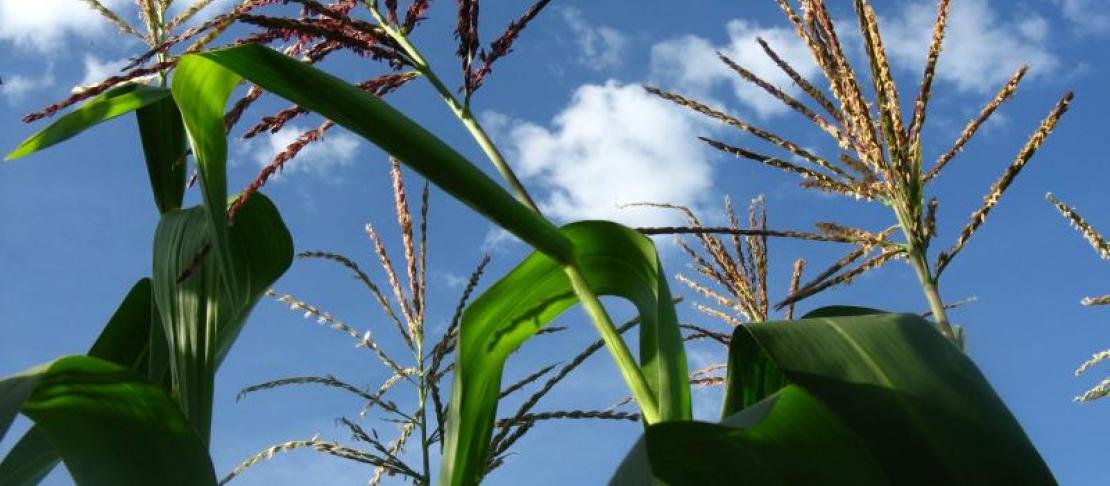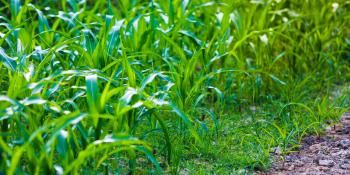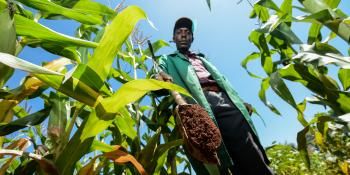Bringing CSA practices to scale: assessing their contributions to narrow nutrient and yield gaps

Project description
The Crop Nutrient Gap project aims to substantially increase the cereal food production in sub-Saharan Africa (SSA) by focusing on the potential of crop nutrient management with minimum greenhouse gas emissions and soil nutrient mining. The project assessed the increase in cereal demand until the year 2050 based on population growth and dietary change for ten SSA countries (Burkina Faso, Ghana, Mali, Niger, Nigeria, Ethiopia, Kenya, Tanzania, Uganda, Zambia). Using crop growth models, we evaluated whether SSA can be self-sufficient for cereals (maize, millet, rice, sorghum and wheat) in 2050 by intensifying crop production on existing cereal area. Next, within the project estimations were done on minimum required nutrient inputs (NPK) to prevent soil nutrient mining. For each country different scenarios of intensification and/or cropland expansion were explored, and greenhouse gas (GHG) emissions from fertilizers and land use change were calculated.
Intensification requires large increases in nutrient inputs and will therefore result in extra GHG emissions. Yet, it can bring much lower GHG emissions than cropland (cereal) expansion, but this depends on agronomic nitrogen use efficiency achieved. Thus, both avoidance of expansion and the widespread adoption of climate-smart agricultural practices leading to high nutrient use efficiency can mitigate GHG emissions.
The project therefore also assesses different options to increase rates of nitrogen use efficiencies and economic feasibilities in Ethiopia and Tanzania by investigating and testing climate-smart nutrient management options employing the “4R nutrient stewardship approach” (i.e., applying nutrients using the right source, at the right rate, at the right time and in the right place). It includes testing the combination of mineral and recycled organic sources of nutrients in on-farm and on-station trials as well as using data-mining and model-based analysis (the use of liming and the role of legumes in nutrient management).
Expected outcomes
- Enabling evidence-based decision making on GHG mitigation at international, regional and local levels
- Revised targets and INDCs for agricultural mitigation
Gender and youth
Gender is not a major focal point of the project, but we will certainly account for gender-specific aspects of nutrient management in the three countries.
More information
For more information, please contact project leader Martin Van Ittersum, WUR (martin.vanittersum@wur.nl).
Project Deliverables
Journal Article (peer reviewed)
1.1 Prospect for increasing grain legume crop production in East Africa
Journal Article (peer reviewed)
1.2 Maize crop nutrient input requirements for food security in sub-Saharan Africa
Database/Dataset/Data documentation
1.3 Maps of nutrient gaps for different percentages of yield gap closure for project countries
Lecture/Training Course Material
3.3 First exploratory experiments of promising nutrient management variants in target countries
Discussion paper/Working paper/White paper
2.1 Method to identify and assess nutrient management variants at field-cropping system level using 4Rs
Discussion paper/Working paper/White paper
4.1 Definition of Technology Extrapolation Domains (TEDs) with climate, soil water and farming system dimensions
Database/Dataset/Data documentation
1.6 Yield gaps of grain legume crops in Ethiopia, Kenya and Tanzania
Journal Article (peer reviewed)
4.4 Beyond the plot: technology extrapolation domains for scaling out agronomic science
Article for media/Magazine/Other (not peer-reviewed)
1.5 Can sub-Saharan Africa feed itself?
Lecture/Training Course Material
5.1 - Field demonstration day of the nutrient management packages
Journal Article (peer reviewed)
1.4 GHG emissions of different intensification scenarios of maize production in SSA
Journal Article (peer reviewed)
4.2 A spatial framework for ex-ante impact assessment of agricultural technologies
Policy brief/policy note/briefing paper
5.4 Can Ethiopia feed itself by 2050? Estimating cereal self-sufficiency to 2050
Discussion paper/Working paper/White paper
3.2 Trade-off analysis at farm level of productivity (physical, economic), NUE and GHG emissions
Research workshop report
3.4 Results from the Fertilizer demonstration experiment with maize at IOP Farm in Iringa, Tanzania in 2018
Maps/Geospatial data
4.3 Scaling out local work at field and farm level to regional and national level
Research workshop report
5.2 - Workshops and Field demos report
Discussion paper/Working paper/White paper
2.3 Testing SpectraCrop Plant Vitality and P Tester
Discussion paper/Working paper/White paper
6.1 NWO-GCP4: Scaling readiness of climate smart, nutrient management decision support tools in different institutional environments - Progress report 2018
Discussion paper/Working paper/White paper
5.3 Theory of Change of Bringing climate-smart nutrient management to scale
Website
1.5 Crop nutrient gaps for four cereals (millet, rice, sorghum and wheat) added to the Global Yield Gap Atlas
Policy brief/policy note/briefing paper
5.6 Fertiliser use and soil carbon sequestration: Key messages for climate change mitigation strategies
Outcome note
3.5 D9593: Results from the Fertilizer demonstration experiment with maize at IOP Farm in Iringa, Tanzania in 2019
Discussion paper/Working paper/White paper
3.3 Fertiliser use and soil carbon sequestration: trade-offs and opportunities
Policy brief/policy note/briefing paper
5.4 Policy brief: Minimum emission pathways to triple Africa’s cereal production by 2050
Journal Article (peer reviewed)
4.5 A spatial framework for ex-ante impact assessment of agricultural technologies
Discussion paper/Working paper/White paper
6.5 NWO-GCP4: Performance trials on different rates and ratios of N and P fertilisation in Ethiopia to inform field-specific Maize-Nutrient-Management advisory
Discussion paper/Working paper/White paper
6.2 NWO-GCP4: Maize-Nutrient-Manager: A mobile phone application for field-specific, balanced nutrient management advisory
Discussion paper/Working paper/White paper
1.7 Benchmarking crop nutrient requirements, nutrient use efficiencies and mitigation potentials of major cereal crops and climate conditions in SSA
Discussion paper/Working paper/White paper
Results from the fertilizer demonstration experiment with maize at Farm for the Future Tanzania in Iringa, in 2020
Discussion paper/Working paper/White paper
6.6 NWO-GCP4: Content development for field-specific, climate-smart, balanced nutrient management advisory tool in Tanzania.
Discussion paper/Working paper/White paper
6.5 NWO-GCP4: Analysis of performance on-farm trials on different levels and ratios of N and P fertilization for the development of pragmatic, balanced nutrient advisory
Thesis
1.8 Observed and theoretical nutrient use efficiencies of millet, rice, sorghum and millet in SSA
Thesis
6.4 NWO-GCP4: Evaluation of balanced nutrient supply and management advisory in smallholder maize production in Songwe region,Tanzania.
Other Capacity
Maize-Nutrient-Manager: Training workshops, Songwe Regions, Tanzania
Outcome note
6.6 NWO-GCP4: Use and data collected in 2019-2020 season, Songwe region, Tanzania
Partners
- Centro Internacional de Mejoramiento de Maíz y Trigo (CIMMYT)
- Ethiopian Institute of Agricultural Research (EIAR)
- International Fertiliser Association (IFA)
- International Livestock Research Institute (ILRI)
- National Agricultural Research Organisation (Uganda) (NARO)
- Sokoine University of Agriculture (SUA)
- University of Nebraska
- Wageningen University and Research Centre (WUR)
- YARA


